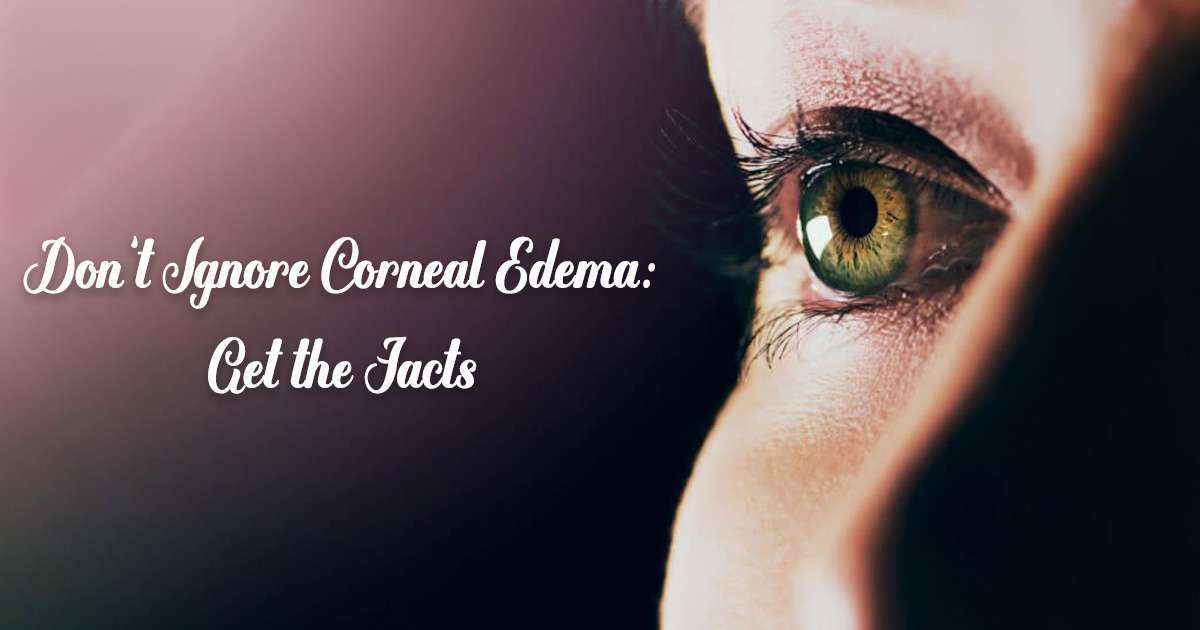Learn the Basics of Corneal Edema: What is It?

Corneal edema is a condition that affects the clear, front surface of the eye, leading to vision problems and discomfort. But what is corneal edema exactly, and how can it be managed? Understanding this condition is crucial for maintaining eye health and seeking appropriate treatment when necessary.
What is Corneal Edema?
Corneal edema, also known as cornea swelling, occurs when fluid accumulates in the cornea, causing it to become swollen and cloudy. The cornea is essential for focusing light onto the retina, and any swelling can significantly impair vision. This condition can result from various factors, including underlying medical issues, eye surgery, or prolonged contact lens use.
What are the Causes of Corneal Edema?
Corneal edema can be caused by several factors, including:
- Fuchs’ Dystrophy: A hereditary condition that affects the innermost layer of the cornea.
- Eye Surgery: Procedures like cataract surgery can sometimes lead to corneal swelling.
- Trauma: Physical injury to the eye can cause the cornea to swell.
- Infections: Bacterial, viral, or fungal infections can result in corneal edema.
- Prolonged Contact Lens Wear: Wearing contact lenses for too long without proper hygiene can lead to swelling.
- Glaucoma: Increased eye pressure can cause damage to the cornea, leading to edema.
- Medications: Certain eye drops or systemic medications can have side effects that cause corneal swelling.
Symptoms of Corneal Edema
Identifying the symptoms of corneal edema is crucial for early diagnosis and treatment. Symptoms include:
- Blurry or Hazy Vision: Vision may appear foggy or blurred.
- Halos Around Lights: Lights may have a halo or glare effect.
- Eye Discomfort: The eye may feel sore or irritated.
- Grittiness: A sensation of having something in the eye.
- Redness: The eye may appear red and inflamed.
- Sensitivity to Light: Increased sensitivity to bright lights.
- Vision Fluctuations: Vision may change throughout the day, often worse in the morning.
Treatment Options for Corneal Edema
Treating corneal edema involves addressing both the symptoms and underlying causes. Effective treatment can help improve vision and reduce discomfort. Here are some common treatment options:
Eye Drops
Hypertonic saline eye drops are often prescribed to reduce corneal swelling. These drops work by drawing excess fluid out of the cornea, helping to clear up vision and reduce cloudiness. They are usually applied several times a day and can provide significant relief from the symptoms of corneal edema. It’s important to follow the dosage instructions provided by your eye care professional to achieve the best results.
Using a Hair Dryer
A surprising but effective home remedy involves using a hair dryer. Holding the hair dryer at arm’s length and blowing warm air on the closed eyelids can help evaporate excess fluid from the cornea. This method should be used with caution to avoid eye dryness or irritation. Typically, it is recommended to do this for a few minutes each day, but always consult with an eye specialist before trying new treatments at home.
Contact Lens Assessment
For those who wear contact lenses, a thorough assessment is crucial. Contact lenses that don’t allow enough oxygen to reach the cornea can exacerbate swelling. Switching to lenses with higher oxygen permeability or taking a break from lens use can significantly reduce swelling. Additionally, ensuring proper hygiene and replacing lenses as recommended can help prevent further issues.
Medications
Anti-inflammatory medications, either in eye drop form or systemic, can help reduce inflammation and swelling in the cornea. These medications work by reducing the body’s inflammatory response, which can contribute to corneal edema. They are often used in conjunction with other treatments to provide comprehensive relief. Always use these medications under the guidance of a healthcare provider to avoid potential side effects.
Surgery
In severe cases, surgical intervention may be necessary. Procedures like corneal transplantation can replace the damaged corneal tissue with healthy donor tissue, effectively treating the edema. Another surgical option is Descemet’s Stripping Automated Endothelial Keratoplasty (DSAEK), which specifically targets the innermost layer of the cornea. Surgery is generally considered when other treatments have not been successful in reducing swelling and restoring vision.
Bandage Contact Lenses
Special bandage contact lenses can be used to protect the cornea and reduce pain. These lenses help maintain a moist environment, promoting healing and comfort. They act as a barrier, preventing the eyelid from rubbing against the cornea, which can reduce irritation and allow the cornea to heal more effectively. These lenses are typically used temporarily until the cornea has recovered.
Determining and Treating Underlying Medical Conditions
Addressing underlying conditions like Fuchs’ dystrophy or glaucoma is essential. Proper management of these conditions can prevent further corneal damage and reduce the risk of edema recurrence. For example, in the case of Fuchs’ dystrophy, managing the disease with regular eye check-ups and appropriate treatments can help maintain corneal health. Similarly, controlling eye pressure in glaucoma patients can prevent damage to the cornea and other parts of the eye.
Taking Action Against Corneal Edema
Corneal edema is a serious condition that requires prompt attention and treatment. Understanding what is corneal edema, recognizing its causes, and identifying its symptoms are the first steps toward effective management. With the right treatment plan, including options like eye drops, medications, and even surgery, individuals can improve their vision and eye health. Always consult with an eye care professional for a thorough diagnosis and personalized treatment plan to ensure the best outcomes for your eye health.

